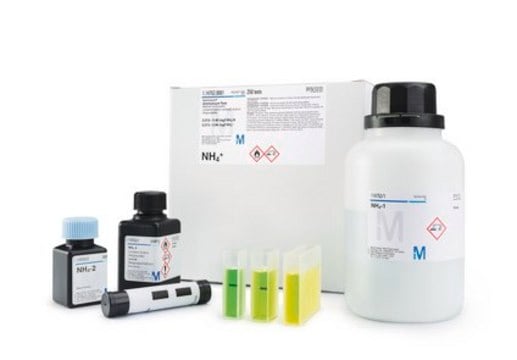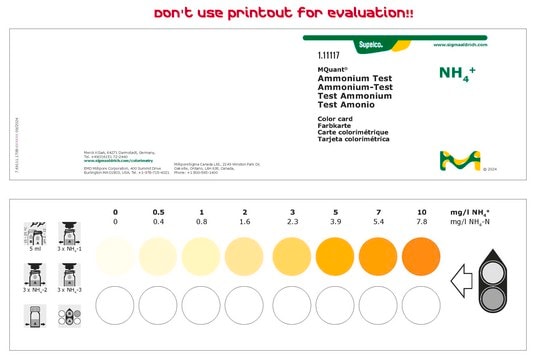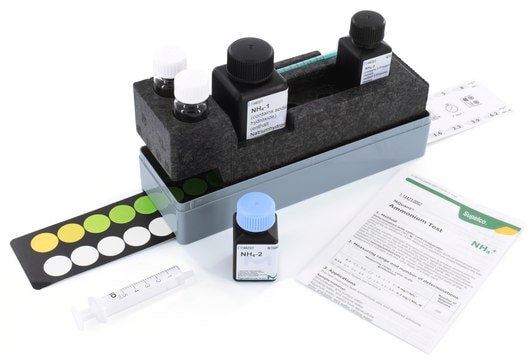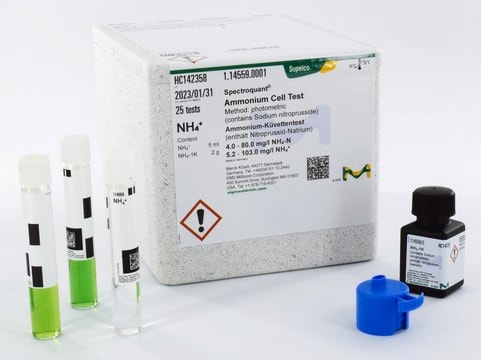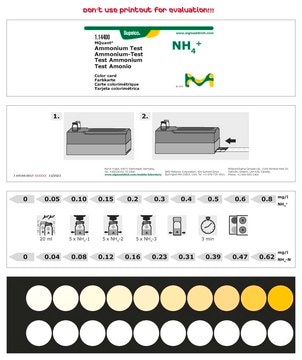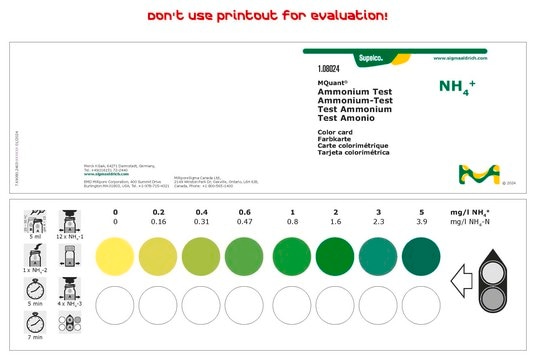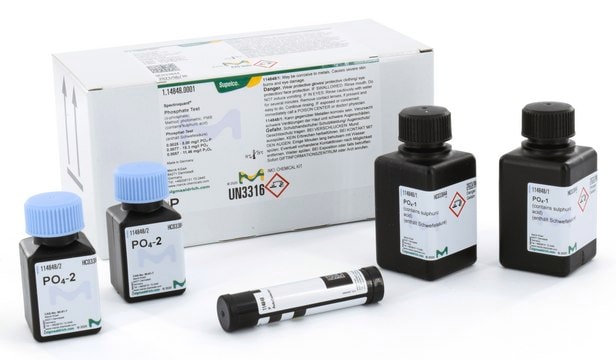1.14752
Ammonium Test, photometric
photometric, 0.010-3.00 mg/L (NH4-N), Spectroquant®
Select a Size
About This Item
Recommended Products
Product Name
Ammonium Test, photometric, 0.010-3.00 mg/L (NH4-N), Spectroquant®
product line
Spectroquant®
Quality Level
usage
sufficient for 250 tests (depending on package size)
sufficient for 500 tests
specific analyte(s)
ammonium
measuring range
0.010-3.00 mg/L (NH4-N)
0.013-3.86 mg/L (NH4+)
technique(s)
photometry: suitable
application(s)
agriculture
aquaculture
boiler and cooling water
drinking water
environmental
food testing
ground and surface water
mineral water
oil and petrochemicals
power plants
seawater
swimming pools
wastewater
compatibility
for use with Spectroquant® Move 100
for use with Spectroquant® Nova 60 A
for use with Spectroquant® Prove 100 (plus)
for use with Spectroquant® Prove 300 (plus)
for use with Spectroquant® Prove 600 (plus)
detection method
photometric (Indophenol blue)
1 of 1
This Item | 100683 | 111117 | 114400 |
|---|---|---|---|
| specific analyte(s) ammonium | specific analyte(s) ammonium | specific analyte(s) ammonium | specific analyte(s) ammonium |
| detection method photometric (Indophenol blue) | detection method photometric (Indophenol blue) | detection method colorimetric | detection method colorimetric |
| technique(s) photometry: suitable | technique(s) photometry: suitable | technique(s) - | technique(s) - |
| measuring range 0.010-3.00 mg/L (NH4-N), 0.013-3.86 mg/L (NH4+) | measuring range 2.0-150 mg/L (NH4-N), 2.4-193 mg/L (NH3), 2.6-193 mg/L (NH4+) | measuring range 0.5-10 mg/L (NH4+) | measuring range - |
| compatibility for use with Spectroquant® Nova 60 A, for use with Spectroquant® Prove 300, for use with Spectroquant® Move 100, for use with Spectroquant® Prove 600, for use with Spectroquant® Prove 100 | compatibility for use with Spectroquant® Move 100, for use with Spectroquant® Nova 60 A, for use with Spectroquant® Prove 100, for use with Spectroquant® Prove 300, for use with Spectroquant® Prove 600 | compatibility for use with MQUANT® | compatibility for use with MQUANT® |
| product line Spectroquant® | product line Spectroquant® | product line - | product line - |
General description
The method is analogous to EPA 350.1, APHA 4500-NH3 F, ISO 7150-1, and DIN 38406-5.
This Spectroquant® Ammonium Reagent Test allows the cyanide-free quantification of ammonium in wastewater, groundwater, surface water, and seawater. Typically, ammonium enters water sources as run-off from fertilized agricultural areas and enhanced levels are important indicators of fecal pollution.
Further fields of applications are the analysis of foods & beverages and of environmental and agricultural samples (e.g. soil).
The Spectroquant® Reagent Test Kits contain highly stable, ready-to-use reagent mixtures to perform the analysis according to the procedure described in the accompanying instruction leaflet.
All our Cell and Reagent Test Kits are equipped with the unique Live ID (2D barcode) which allows seamless method recognition and contains essential information such as lot number, expiry date, and automatic calibration updates.
Legal Information
Signal Word
Danger
Hazard Statements
Precautionary Statements
Hazard Classifications
Acute Tox. 4 Oral - Aquatic Chronic 3 - Eye Dam. 1 - Flam. Liq. 2 - Met. Corr. 1 - Skin Corr. 1B - STOT SE 3
Target Organs
Central nervous system
Storage Class Code
3 - Flammable liquids
WGK
WGK 3
Certificates of Analysis (COA)
Search for Certificates of Analysis (COA) by entering the products Lot/Batch Number. Lot and Batch Numbers can be found on a product’s label following the words ‘Lot’ or ‘Batch’.
Already Own This Product?
Find documentation for the products that you have recently purchased in the Document Library.
Customers Also Viewed
Protocols
Ammonium is the naturally preferred source of nitrogen for plant growth and there is an increasing global demand for organic food products.
Step-by-step method describing the photometric determination of ammonium ions in effluents using Spectroquant® test kits and spectrophotometer.
Learn about the photometric determination of ammonium ions in manure samples by indophenol blue method using Spectroquant ® test kits and spectrophotometer.
Photometric determination of ammonium ions in organic fertilizers by indophenol blue method using Spectroquant® test kits and spectrophotometer.
Our team of scientists has experience in all areas of research including Life Science, Material Science, Chemical Synthesis, Chromatography, Analytical and many others.
Contact Technical Service

